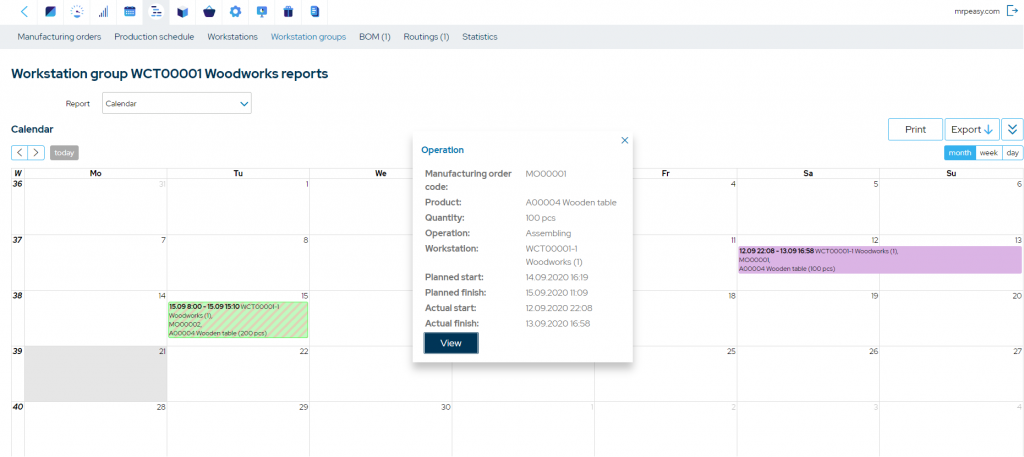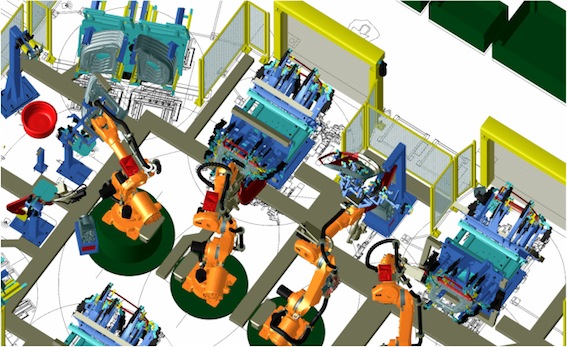Manufacturing Execution System Software as a Cloud-Based Solution
From better scalability to integrated data management – there are numerous advantages to having Manufacturing Execution System software as a cloud-based solution.

You can also listen to this article:
As automation increases through the introduction of new technology such as Industry 4.0 and other initiatives, companies continuously look for ways to improve productivity, manage production workflow, and capture higher efficiencies.
Many companies utilize ERP systems to capture transactional data and standardize information across the company.
Likewise, they may also implement process control software on a specific basis to improve throughput and efficiency.
Between these two tiers of software are programs such as Manufacturing Execution Systems (MES) that operate between the higher-level ERP and floor level process control mechanisms to interpret data to provide real-time workflow visibility, flexibility, and insights into manufacturing operations, and provide a path to improvements.

What is a Manufacturing Execution System (MES)?
An MES is a data and information system that helps companies uncover solutions to optimize and improve manufacturing operations.
An MES connects, monitors, and controls the data flow within manufacturing as it occurs on the factory floor.
Its goal is to effectively execute manufacturing operations while improving production output.
Because it tracks and gathers data in real-time, information about the production cycle from order release to delivery can be leveraged for process improvement.
This includes information such as WIP management, traceability, performance, and materials management through the product cycle.
According to the Manufacturing Enterprise Solutions Associations (MESA), MES systems’ core functions include:
- Operations/detailed sequencing
- Resource allocation and status
- Dispatching production unit
- Performance analysis
- Maintenance management
- Process Management
- Quality management
- Data collection/acquisition
- Product tracking and genealogy
- Labor management
- Document control
As this list suggests, an MES system drills down to capture and manage data specifically for the benefit of the manufacturing process.

Benefits of using an MES system include:
- Better equipment utilization
- Reduced WIP inventory and overall optimization of inventory
- Reduced labor costs
- Significantly fewer manual data-entry processes
- Better supply chain visibility
- Reduced manufacturing cycle time
Cloud-Based vs. On-Premises MES Systems
By combining the benefits of an MES system with an ERP system, companies can collect their factory data in a connected and integrated fashion.
Because MES manages overall production, the solutions it provides can help manufacturers gain insights into their factory operations and supply chain to improve the quality of data input to the ERP.
A Manufacturing Execution System as a cloud-based software makes the most sense in today’s world.
While larger companies have a heavier IT footprint for managing on-premises deployments, there are disadvantages with on-premises MES that make a cloud-based deployment more desirable.
Disadvantages of on-premises MES
- IT Skills – On-premises software requires advanced IT skillsets for deployment, management, and maintenance. This alone would impact the effectiveness of on-premises MES for small to medium-sized businesses (SMB) who lack the in-house IT skills or the ability to maintain an ongoing system. This means that SMBs would need to subcontract for ongoing maintenance or do without – neither of which are effective solutions.
- Learning Curve and Training – Like most on-premises software, an in-house MES system would require training and the cost associated with it. This training is less likely to have online support and learning aids such as interactive tutorials or gamification learning, and risks lower retention of data by those being trained.
- Software Updates – Because on-premises systems are relatively static over a long period of time, updates are a necessary task that must be done regularly. This starts the training/learning curve over again depending on complexity. It is also costly and may risk data loss or degradation depending on the skillset of those using the system. And it may mean that companies forego the timeliness of updates, again degrading the effectiveness of the system.

A cloud-based MES can be integrated with today’s ERP systems, many of which are also cloud-based. Because of this, cloud-based MES has many advantages.
Advantages of a cloud-based Manufacturing Execution System software
- Software is Always Current – Cloud-based software has an advantage that on-premises can never achieve. As it is continually attached to the cloud, it receives all software updates in real-time on an ongoing basis. This ensures that users always have access to the most current version, eliminating the possibility of obsolescence.
- More Cost-Effective – A cloud-based MES will always be more cost-effective compared to on-premises. This saves money because expensive IT infrastructure upgrades are not required. It also means that both in-house skillsets and ongoing maintenance skillsets are not needed as deeply as in companies with on-premises systems. Upfront and ongoing training costs are also reduced as learning can be done iteratively with tutorials and other online aids. As a result, the total cost of ownership for cloud-based MES software is much lower.
- Modular or Needs-based System – Many on-premises traditional software systems are “blocky” in that they offer specific functionality with little opportunity to control user experience. This means that if a company doesn’t need specific aspects of the program, users are still exposed to it. This slows down user experience and makes user interfaces more time consuming to navigate. Cloud-based MES is often customizable to both the company and the individual user. This allows for user interfaces and user experiences that are tailored to specific needs, improving the experience, efficiency, and user satisfaction.
- Scalability – Cloud-based software can act to “level the playing field” for small and medium-sized businesses (SMB). Traditionally, when on-premises software was the only option, SMBs lacked the IT skills and the capital to invest in a sophisticated system. Because cloud-based MES software is modular and intuitive, SMBs have access to state-of-the-art and best-in-class software to put them on par with larger companies. As they grow, this modularity can be added for scaling to new requirements in functionality without having to invest in a new system.
- Connected Factory – Since MES cloud-based software can be integrated with ERP systems and other enterprise software, it offers an opportunity for a connected factory to allow even the smallest company to take advantage of Industry 4.0 technology. This means that all systems as well as servers, data storage devices, networks, and other integrated software allow for visualization of the production floor with data and insights that benefit from unsiloed information.
Conclusion
Manufacturing Execution Systems as cloud-based software makes sense both from a practical and an operational sense.
This software exists today and can be deployed quickly, cost-effectively, and with a reduced requirement for in-house IT structure and to the benefit of companies of any size.
You may also like:
Cloud-based ERP vs. On-Premise ERP for Small Manufacturing Business
Software for Manufacturing Business – What to Look for?




